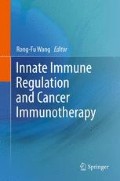Abstract
Immune system is composed of innate and adaptive responses and plays critical roles in cancer development and destruction. A century ago, Paul Ehrlich postulated that cancer would be quite common in long-lived organisms if not for the protective effects of immunity. About 50 years later, Burnet and Thomas proposed the concept of cancer immunosurveillance based on the experimental evidence of immune recognition of tumor antigens expressed on tumor cells (Dunn et al. 2004). In 1971, the US Congress created a National Cancer Act – a War on Cancer. Among many tough questions asked were whether the immune system can be manipulated so that it recognizes tumor cells as foreign invaders that must be eliminated from the body and whether viruses play a role in human cancer. In 1980s, Steven Rosenberg and his colleagues developed adoptive cell therapy (ACT) for the treatment of melanoma cancer patients using lymphocyte activated killed (LAK) cells, providing the first direct evidence that the immune system can be manipulated to achieve therapeutic efficacy of cancer treatment (Rosenberg, 2011). In 1990s, many human tumor antigens such as MAGE and NY-ESO-1 have been identified from melanoma and many other types of cancer using tumor-reactive T cells, thus setting the stage for the development of cancer vaccines in the twenty-first century (Wang and Rosenberg, 1999). Indeed, the first dendritic cell (DC)-based vaccine was approved in 2010 by the U.S. Food and Drug Administration (FDA) for the treatment of patients with prostate cancer.
Access this chapter
Tax calculation will be finalised at checkout
Purchases are for personal use only
References
Akira S, Uematsu S, Takeuchi O (2006) Pathogen recognition and innate immunity. Cell 124:783–801
Clevers H (2004) At the crossroads of inflammation and cancer. Cell 118:671–674
Condeelis J, Pollard JW (2006) Macrophages: obligate partners for tumor cell migration, invasion, and metastasis. Cell 124:263–266
Coussens LM, Werb Z (2002) Inflammation and cancer. Nature 420:860–867
Dunn GP, Old LJ, Schreiber RD (2004) The immunobiology of cancer immunosurveillance and immunoediting. Immunity 21:137–148
Greten FR, Eckmann L, Greten TF, Park JM, Li ZW, Egan LJ, Kagnoff MF, Karin M (2004) IKKbeta links inflammation and tumorigenesis in a mouse model of colitis-associated cancer. Cell 118:285–296
Karin M, Greten FR (2005) NF-kappaB: linking inflammation and immunity to cancer development and progression. Nat Rev Immunol 5:749–759
Karin M, Lawrence T, Nizet V (2006) Innate immunity gone awry: linking microbial infections to chronic inflammation and cancer. Cell 124:823–835
Koebel CM, Vermi W, Swann JB, Zerafa N, Rodig SJ, Old LJ, Smyth MJ, Schreiber RD (2007) Adaptive immunity maintains occult cancer in an equilibrium state. Nature 450:903–907
Rosenberg SA (2011). Cell transfer immunotherapy for metastatic solid cancer-what clinicians need to know. Nat Rev Clin Oncol
Smyth MJ, Crowe NY, Godfrey DI (2001) NK cells and NKT cells collaborate in host protection from methylcholanthrene-induced fibrosarcoma. Int Immunol 13:459–463
Sun J, Wiklund F, Zheng SL, Chang B, Balter K, Li L, Johansson JE, Li G, Adami HO, Liu W et al (2005) Sequence variants in Toll-like receptor gene cluster (TLR6-TLR1-TLR10) and prostate cancer risk. J Natl Cancer Inst 97:525–532
Wang RF, Rosenberg SA (1999) Human tumor antigens for cancer vaccine development. Immunol Rev 170:85–100
Wang HY, Wang RF (2007) Regulatory T cells and cancer. Curr Opin Immunol 19:217–223
Xu J, Lowey J, Wiklund F, Sun J, Lindmark F, Hsu FC, Dimitrov L, Chang B, Turner AR, Liu W et al (2005) The interaction of four genes in the inflammation pathway significantly predicts prostate cancer risk. Cancer Epidemiol Biomarkers Prev 14:2563–2568
Author information
Authors and Affiliations
Corresponding author
Editor information
Editors and Affiliations
Rights and permissions
Copyright information
© 2012 Springer Science+Business Media, LLC
About this chapter
Cite this chapter
Wang, RF. (2012). Introduction. In: Wang, R. (eds) Innate Immune Regulation and Cancer Immunotherapy. Springer, New York, NY. https://doi.org/10.1007/978-1-4419-9914-6_1
Download citation
DOI: https://doi.org/10.1007/978-1-4419-9914-6_1
Published:
Publisher Name: Springer, New York, NY
Print ISBN: 978-1-4419-9913-9
Online ISBN: 978-1-4419-9914-6
eBook Packages: Biomedical and Life SciencesBiomedical and Life Sciences (R0)

